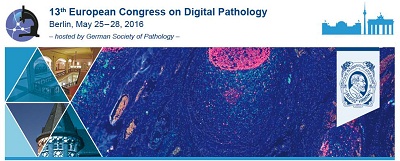Semi-Automatic Classification Of Histopathological Images: Dealing With Inter-Slide Variations
Abstract
Introduction/ Background
The large size and high resolution of histopathological whole slide images renders their manual annotation time-consuming and costly. State-of-the-art computer-based segmentation approaches are generally able to classify tissue reliably, but strong inter-slide variations between training and evaluation data can cause significant decreases in classification accuracy.
Aims
In this study, we focus on alpha-SMA stainings of the mouse kidney, and in particular on the classification of glomerular vs. non-glomerular regions. Even though all slides had been recorded using a common staining protocol, inter-slide variations could be observed. We investigate the impact of these variations as well as methods of resolution.
Methods
We propose an interactive, semi-automatic tissue classification approach [1] which adapts a pre-trained classification model to the new image on which classification should be performed. Image patches for which the class (glomerular/non-glomerular) is uncertain are automatically selected and presented to the user to determine the class label. The user interaction step is repeated several times to iteratively adjust the model to the characteristics of the new image. For image representation and classification, well known methods from the literature are utilized. Specifically, we combine Local Binary Patters with the support vector classifier.
Results
In case of 50 available labelled sample patches of a certain whole slide image, the overall classification rate increased from 92 % to 98 % through including the interactive labelling step. Even with only 20 labelled patches, accuracy already increased to 97 %. Without a pre-trained model, if training is performed on target domain data only, 88 % (20 labelled samples) and 95 % (50 labelled samples) accuracy, respectively, were obtained. If enough target domain data was available (about 20 images), the amount of source domain data was of minor relevance. The difference in outcome between a source domain training data set containing 100 patches from one whole slide image and a set containing 700 patches from seven images was lower than 1 %. Contrarily, without target domain data, the difference in accuracy was 10 % (82 % compared to 92 %) between these two settings. Execution runtime between two interaction steps is significantly below one second (0.23 s), which is an important usability criterion.
It proved to be beneficial to select specific target domain data in an active learning sense based on the currently available trained model. While experimental evaluation provided strong empirical evidence for increased classification performance with the proposed method, the additional manual effort can be kept at a low level. The labelling of e.g. 20 images per slide is surely less time consuming than the validation of a complete whole slide image processed with a fully automatic, but less reliable, segmentation approach. Finally, it should be highlighted that the proposed interaction protocol could easily be adapted to other histopathological classification or segmentation tasks, also for implementation in a clinical system.
Â
Downloads

This work is licensed under a Creative Commons Attribution-ShareAlike 4.0 International License.
Authors who publish with this journal agree to the following terms:
1. Authors retain copyright and grant the journal right of first publication with the work simultaneously licensed under a Creative Commons Attribution License that allows others to share the work with an acknowledgement of the work's authorship and initial publication in this journal.
2. Authors are able to enter into separate, additional contractual arrangements for the non-exclusive distribution of the journal's published version of the work (e.g., post it to an institutional repository or publish it in a book), with an acknowledgement of its initial publication in this journal.
3. Authors are permitted and encouraged to post their work online (e.g., in institutional repositories or on their website) prior to and during the submission process, as it can lead to productive exchanges, as well as earlier and greater citation of published work (See The Effect of Open Access).
4. In case of virtual slide publication the authors agree to copy the article in a structural modified version to the journal's VS archive.








